Cauliflower as a vegetable that can come across as pretty boring, but add the right ingredients to it and “voila” you can have a masterpiece in your hands. [recipe updated 5 June 2020]
You could easily convert it to a amazingly yummy cauliflower bake recipe or then why not make something different with a bit of a kick to it. The Indian Aloo Gobi is the perfect candidate if you want something yummy yet different.
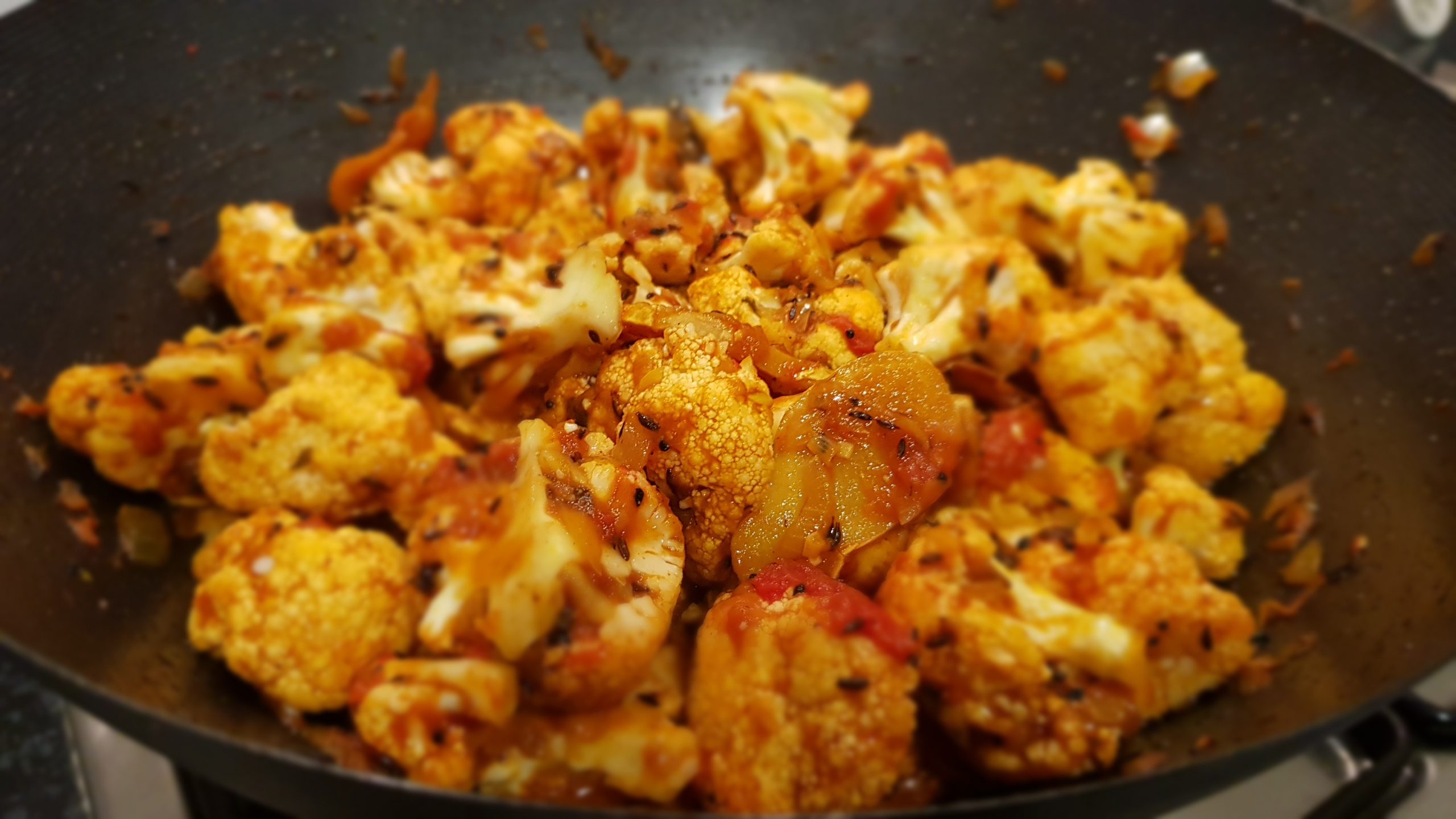
Aloo gobi (from Punjabi), also spelled alu gobi, or aloo gobhi (from Hindi आलू गोभी) and is usually a “dry” Indian curry, i.e. it often does not have much gravy.
It is a popular combination of aloo (potato) and gobi (cauliflower) mixed with Indian spices. When cooked it gets a yellow colour, because of the turmeric spice whihc is the main spice ingredient. Its a good vegetarian recipe.
This dish can be cooked as a “north Indian recipe” or as a “south Indian recipe” flavor which contains curry leaves.
Among other ingredients that are also used in variations include garlic, ginger, onion, fresh coriander , tomato, and cumin. A number of variations and similar dishes exist, but the name remains the same.
Use prep time to partially boil potatoes and cut he cauliflower into small florets.
RECIPE
INGREDIENTS
- 3 to 6 tablespoons vegetable oil
- 1/4 tsp mustard seed
- 1 pinch asafoetida powder
- 1/4 tsp cumin seeds
- 1 small onion diced finely
- 1 pinch turmeric powder
- 3 tomatoes, chopped Or half a can diced tomatoes
- 2 tablespoons minced fresh ginger
- 1 or 2 fresh chillies sliced (optional)
- 2 potato, cubed (partially cooked)
- 1 Cauliflower, broken into small florets ( if big use half)
- 1/2 tsp white sugar
- 1 or 2 pods garlic chopped
- 1/4 tsp sugar
- 1 tablespoon fenugreek leaves
- 1 tsp amchur (tangy mango powder)
- salt to taste
- 1/2 tsp garam masala (optional)
- 1/2 tsp coriander powder (optional)
Recipe Method
- Partially Boil (70%) two small diced potatoes separately in water with a pinch of salt. (Poke with fork to see if firm and not too soft when it is cooking. If firm its ready.)
- Heat oil over a medium-high heat. Toss in the mustard seeds- when they start spluttering in oil, add the asafoetida, followed by the cumin seeds. Mix for a minute then add ginger, garlic stir and saute for a 2 more minutes.
- Add diced onions to the mix and keep stirring for 7 minutes on a medium to high flame to cook onions.
- Add the spices turmeric powder, garam masala, coriander powder, fresh chilli and fenugreek leaves and stir for 5 to 7 minutes.
- Add the cauliflower florets, sugar and salt mango powder and stir well. Add half of cup of water and cook until the cauliflower are tender yet crunchy ( approximately 15 to 20 minutes). Lower the flame. If you want a bit of gravy cover dish and let it cook . If you prefer dry keep stirring while dish is open and cooking.
- Add the potatoes 5 minutes before you finish cooking the cauliflower so that they do not get too mashed up with the cauliflower.
This dish can be had with wholemeal bread/ turkish bread or then Indian paratha/roti or as an dry curry with boiled rice.
More pics
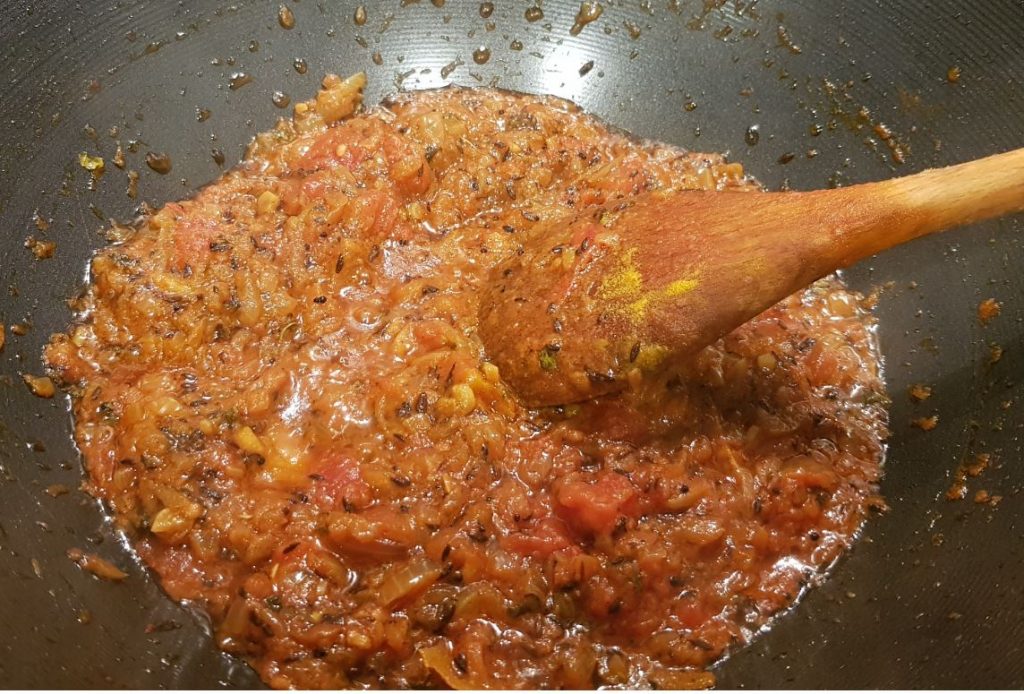
Above: Mixing the spices with onion and tomatoes
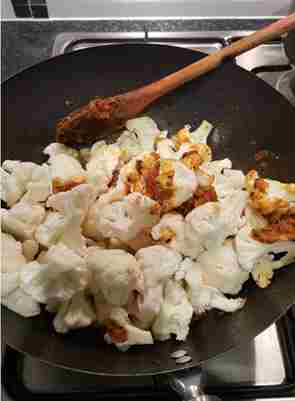
Above: Adding cauliflower florets to spice mix
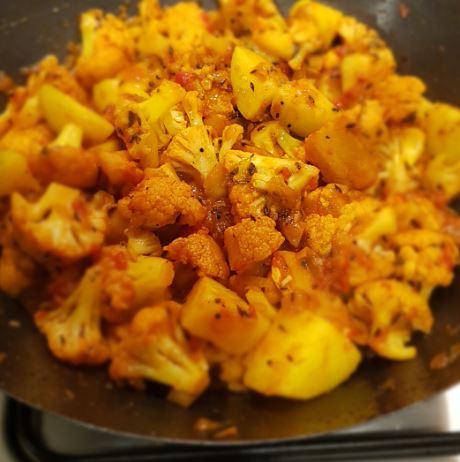
Above: final cauliflower with potatoes
This dish has a prominent role in the movie Bend It Like Beckham—the film’s DVD contains a featurette titled How to cook Aloo gobi., with the film’s director making the dish.
This led to the pickup line ‘Why cook aloo gobi, when you can Bend It Like Beckham”.
If you are interested in more vegan recipes or a similar recipe only with potatoes try our -> aloo-sukha-recipe
The History of Recipes :
Food historians have tracked the existence of recipes back into antiquity, at least as far back into history as the ancient Egyptians, and maybe further still.
Interesting though that is, generally, these ancient recipes were just very basic pictorial instructions for meal preparation. Interestingly, the oldest recipe found, according to experts is a collection of stone tablets in Sumerian which describe the baking of bread which is then used to make a drink, quite possibly a form of beer as it is recorded as having made drinkers feel `exhilarated, wonderful and blissful`.
As we move into The time of the romans 25BC a roman called Apicius compiled a few documents describing recipes cooked by wealthy roman citizens. In his works, Apicius recounts how the meals were separated into starters, main course and desserts, known in latin as `Gustatio, Primae Mensae and Secundae Mensae`.
Additionally, he tells us how the cooks of his times were skilled in the use of many different herbs, including a few that are still present in modern kitchens for example bay, fennel and parsley.
Later, in the 15th century, people returning from the crusades brought us many foods, spices and herbs from Arab cooking, including coriander, parsley, and basil.
These new spices and herbs was responsible for an increase in recipe books, some of which are now in private collections. During the succeeding few centuries, the rich and powerful families of Europe competed with each other to lay on the best banquets, and as a consequence, the best cooks and their recipes were much in demand.
Even so, it was during the nineteenth century that cookery and recipe publications became popular. Mrs Beeton in the UK, and the equally famous Fannie Farmer in the US, devoted much of their lives to collating, verifying, and recording the recipes of their peers.
Like it or not, the introduction of TV brings us cooking programs and the spin-off recipe books. Which pretty much brings us up to date and the invention of computers and the internet, allowing everyone to access massive numbers of recipes like those on the site you are now reading.

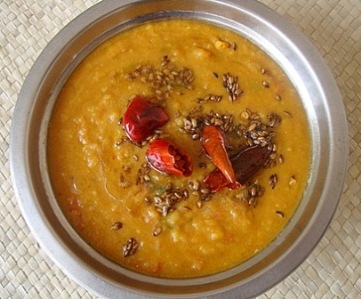
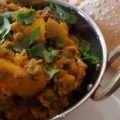
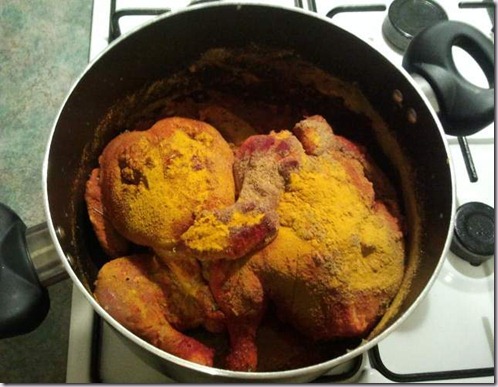
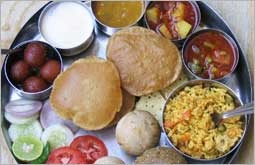

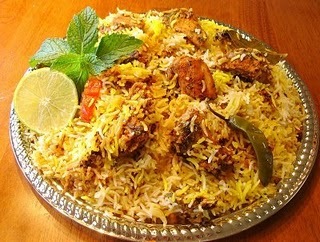

This is nice blog to visit lot new things about making different recipies are learned from this blog . Punjabi dishes is simple, healthy and yet has its own fascination. The famous dishes like matar paneer, dal makhani, parathas, bature, lassi are popular all over India.